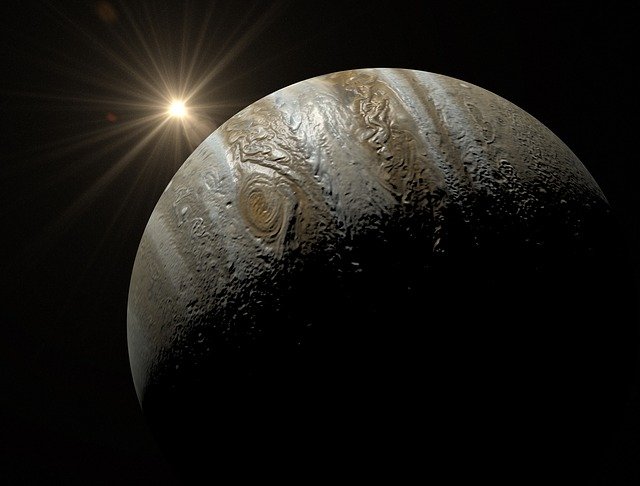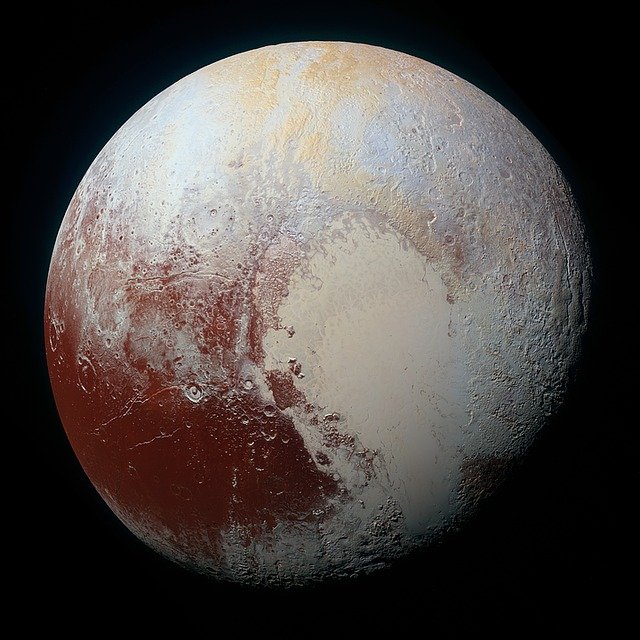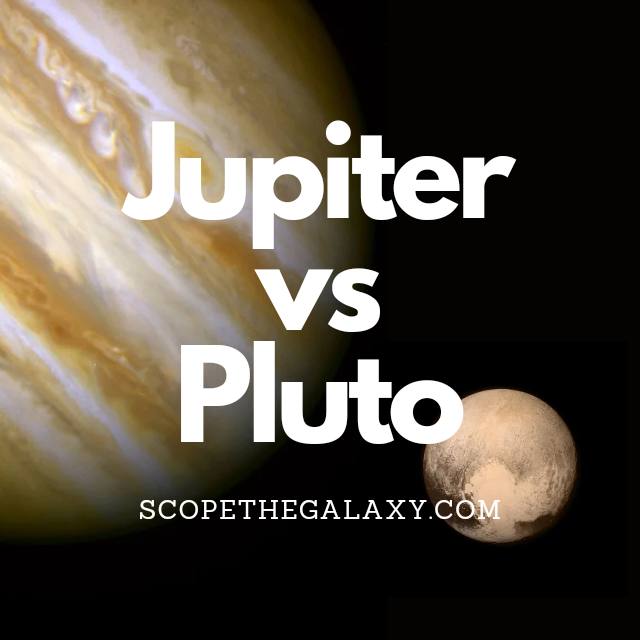*This post may contain affiliate links. This means we may make a commission if you purchase an item using one of our links*
The main differences between Jupiter and Pluto is that the former is the largest planet in our solar system that falls under the gas giant moniker whilst the other is the smallest planet in our solar system that was demoted to a dwarf planet in 2006. Pluto is a terrestrial planet whereas Jupiter is made mostly of hydrogen and helium.
There are a variety of other differences between the two so, continue reading if you want a more thorough breakdown of what these differences are.
What Is The Planet Jupiter?
Table of Contents

Jupiter is the 5th farthest planet from the Sun and the largest planet within our local solar system. The planets most recognisable trait is the giant red spot visible on its atmosphere along with the brown horizontal bands flowing across its atmosphere.
As a result of its composition and size, Jupiter falls under the classification of a gas giant.
This is because its composition mostly consists of the elements hydrogen and helium. The split is roughly 71% hydrogen, 27% helium, with the remainder of the elements split throughout the left over 2%.
As the biggest planet in our solar system, Jupiter is 139,820 km or 1,300 Earths in diameter, it has a mass of around 0.001 solar masses, the temperature when inside the clouds are roughly -145 degrees Celsius whilst the core is far hotter, equating in the region of 24,000 degrees Celsius.
Due to its extreme circumstances, gaseous composition and distance from the Sun, the planet is not theoretically capable to support life, from its subzero temperature to the extremely fast 640 km/h winds, and its gravity which may be unsustainable for our bones, roughly 2.4 times greater than Earth’s.
Although the conditions on Jupiter aren’t suitable for us, some of its 79 moons like Europa for example could support life.
This brown giant has a relatively fast rotation around its axis where 1 rotation typically takes 10 hours to make whilst its orbit around the Sun is far longer taking in the region of 12 years for 1 full cycle.
Another feature of Jupiter that is renowned by astronomers is the strength of its magnetic field. In comparison to the other planets in our solar system it is even stronger than our Sun, where it’s over magnetosphere is roughly 20,000 times the strength of Earth.
What this means is that Jupiter’s magnetosphere is able to avert solar winds that are 3 million kilometers away from it.
What Is The Planet Pluto?

In the past Pluto was the 9th farthest official planet in our solar system however, in 2006 after many debates between astronomers, the International Astronomical Union officially downgraded it to a dwarf planet.
The reason for this downgrade at the time was primarily down to Pluto simply being too small when compared to every other planet and even the moons orbiting these planets. Pluto’s dwarf status is still debated to this day but, for now it remains under this dwarf bracket for a planet
Its diameter for example is only 2,370km, which is a third of Earth’s Moon. With that being said, despite the significant size discrepancy Pluto shows, it still does have more moon like objects orbiting it than Earth and I’m not saying just one more.
In total this terrestrial dwarf planet has 5.
Pluto’s atmosphere consists mostly of molecular nitrogen whilst molecules of methane and carbon monoxide have been observed also. As for its surface, it consist mostly of frozen nitrogen, methane, and carbon monoxide ices.
One of Pluto’s most unique characteristic is that Charon (its largest moon) is tidally locked to it and vice versa, which means that the two essentially orbit each other where, in essence only one side of Charon and one side of Pluto’s surface will face each other at any given time.
Pluto’s temperature is between -222 to -232 degrees Celsius based on how close it gets to the Sun when orbiting it, whilst its core temperature isn’t anything too special sitting around 500 – 1,000 degrees Celsius.
The main reason it’s as cold as it is and has a relatively cold core in comparison to the other planets would be mostly down to its size. A larger size would mean more mass could be compressed at the center which would produce more heat at the core.
Pluto’s orbit is also different from the other main plants in our solar system, following an elliptical orbital path as opposed to the circular path the others take. As a result of its distance from the Sun, Pluto will complete each one of these elliptical cycles around the Sun once every 247.78 years.
Even its rotational cycle is very slow, where one cycle is completed in 157 hours. Another interesting fact is the Pluto’s axial tilt is almost on its side at 57 degrees, similar to Uranus.
Similarities Between Jupiter And Pluto
Jupiter and Pluto have a few similarities, some of which include the below:
- Both planets are orbiting the Sun.
- Both have a hotter central core.
- Both have multiple moons.
- Both are a spherical in shape.
- Jupiter and Pluto are both 4.6 billion years old.
Differences Between Jupiter And Pluto
As for the differences between the two, they include the following:
- Jupiter has 4 rings whilst Pluto has none.
- Jupiter is a gas giant/Jovian planet whereas Pluto is a terrestrial planet falling under the dwarf planet moniker.
- Pluto has 5 moons whereas Jupiter has 79.
- Pluto is tidally locked to Charon and vice versa whereas Jupiter is not tidally locked to any of its moons.
- Jupiter is far bigger with a diameter of 139,820 km. On the other hand, Pluto has a diameter of 2,370 km. When taking into account simply the length, roughly 60.3 Plutos could fit across Jupiter however, in regards to volume roughly 203,886 would squeeze inside Jupiter entirely.
- Pluto is far colder where it can range between -222 to -232 degrees Celsius whilst Jupiter is around -145 degrees Celsius. As for their cores, due to Pluto’s size the overall temperature is only around 500 – 1,000 degrees Celsius whereas Jupiter is significantly hotter at 24,000 degrees celsius.
- Jupiter’s magnetic field is significantly stronger than Pluto’s where its gauss rating is 4.3 and Pluto’s magnetic field strength is practically non-existent.
- Pluto will complete an orbit around the Sun every 247.78 Earth years whilst Jupiter tends to complete a cycle in 12 years.
- Pluto has an axial tilt of 57 degrees whilst Jupiter’s tilt is only 3 degrees.
- One day on Jupiter takes around 10 hours whilst Pluto completes a single day in 157 hours.
Summary
Pluto and Jupiter are quite literally worlds apart from one another whether it be their composition, their size, temperature, magnetic field strength and beyond.
Although similar in a few ways, one isn’t an official planet anymore whilst the other is sometimes even compared to brown dwarfs, which is a star (even if it is a failed one at that). All in all both planets are very different and operate distinctly from one another and all of this has been covered in quite some detail throughout this article.


Wowzers! This is awesome 😳🤯